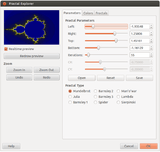Mandelbulb
The Mandelbulb is a three-dimensional fractal, constructed by Daniel White and Paul Nylander using spherical coordinates in 2009.[1]

A canonical 3-dimensional Mandelbrot set does not exist, since there is no 3-dimensional analogue of the 2-dimensional space of complex numbers. It is possible to construct Mandelbrot sets in 4 dimensions using quaternions and bicomplex numbers.
White and Nylander's formula for the "nth power" of the vector in ℝ3 is
where
,
, and
.
The Mandelbulb is then defined as the set of those in ℝ3 for which the orbit of under the iteration is bounded.[2] For n > 3, the result is a 3-dimensional bulb-like structure with fractal surface detail and a number of "lobes" depending on n. Many of their graphic renderings use n = 8. However, the equations can be simplified into rational polynomials when n is odd. For example, in the case n = 3, the third power can be simplified into the more elegant form:
- .
The Mandelbulb given by the formula above is actually one in a family of fractals given by parameters (p,q) given by:
Since p and q do not necessarily have to equal n for the identity |vn|=|v|n to hold. More general fractals can be found by setting
for functions f and g.
Quadratic formula
Other formulae come from identities which parametrise the sum of squares to give a power of the sum of squares such as:
which we can think of as a way to square a triplet of numbers so that the modulus is squared. So this gives, for example:
or various other permutations. This 'quadratic' formula can be applied several times to get many power-2 formulae.
Cubic formula

Other formulae come from identities which parametrise the sum of squares to give a power of the sum of squares such as:
which we can think of as a way to cube a triplet of numbers so that the modulus is cubed. So this gives:
or other permutations.
for example. This reduces to the complex fractal when z=0 and when y=0.
There are several ways to combine two such `cubic` transforms to get a power-9 transform which has slightly more structure.
Quintic formula


Another way to create Mandelbulbs with cubic symmetry is by taking the complex iteration formula for some integer m and adding terms to make it symmetrical in 3 dimensions but keeping the cross-sections to be the same 2 dimensional fractal. (The 4 comes from the fact that .) For example, take the case of . In two dimensions where this is:
This can be then extended to three dimensions to give:
for arbitrary constants A,B,C and D which give different Mandelbulbs (usually set to 0). The case gives a Mandelbulb most similar to the first example where n=9. A more pleasing result for the fifth power is got basing it on the formula: .

Power nine formula

This fractal has cross-sections of the power 9 Mandelbrot fractal. It has 32 small bulbs sprouting from the main sphere. It is defined by, for example:
These formula can be written in a shorter way:
and equivalently for the other coordinates.

Spherical formula
A perfect spherical formula can be defined as a formula:
where
where f,g and h are nth power rational trinomials and n is an integer. The cubic fractal above is an example.
Uses in media
- In the 2014 computer-animated film Big Hero 6, the climax takes place in the middle of a wormhole, which is represented by the stylized interior of a Mandelbulb.[3][4]
- In the 2018 science fiction horror film Annihilation, an extraterrestrial being appears in the form of a partial Mandelbulb.[5]
- In the webcomic Unsounded the spirit realm of the kerht is represented by a stylized golden mandelbulb.
References
- "Hypercomplex fractals".
- "Mandelbulb: The Unravelling of the Real 3D Mandelbrot Fractal". see "formula" section
- Desowitz, Bill (January 30, 2015). "Immersed in Movies: Going Into the 'Big Hero 6' Portal". Animation Scoop. Indiewire. Archived from the original on May 3, 2015. Retrieved May 3, 2015.
- Hutchins, David; Riley, Olun; Erickson, Jesse; Stomakhin, Alexey; Habel, Ralf; Kaschalk, Michael (2015). "Big Hero 6: Into the Portal". ACM SIGGRAPH 2015 Talks. SIGGRAPH '15. New York, NY, USA: ACM: 52:1. doi:10.1145/2775280.2792521. ISBN 9781450336369.
- Gaudette, Emily (February 26, 2018). "What Is Area X and the Shimmer in 'Annihilation'? VFX Supervisor Explains the Horror Film's Mathematical Solution". Newsweek. Retrieved March 9, 2018.
External links
| Wikimedia Commons has media related to Mandelbulb. |
- Mandelbulb: The Unravelling of the Real 3D Mandelbrot Fractal, on Daniel White's website
- Several variants of the Mandelbulb, on Paul Nylander's website
- An opensource fractal renderer that can be used to create images of the Mandelbulb
- Formula for Mandelbulb/Juliabulb/Juliusbulb by Jules Ruis
- Mandelbulb/Juliabulb/Juliusbulb with examples of real 3D objects
- Video : View of the Mandelbulb
- The discussion thread in Fractalforums.com that led to the Mandelbulb
- Video fly through of an animated Mandelbulb world




.jpg)